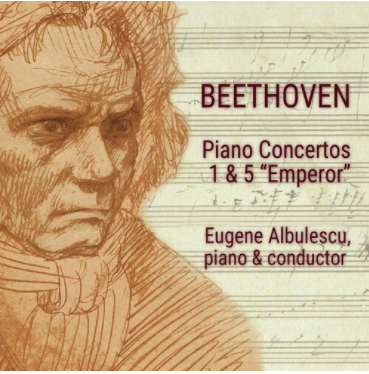CD Review- Beethoven: Piano Concerti, 1 & 5 “Emperor”
Eugene Albulescu, piano & conductor
Orchestra of Friends
AMP Recordings
Catalogue Number: AMPA22.2
One of the things that hasn’t been stripped from the arts community during this pandemic is the joy and pleasure of recorded art. Pianist Eugene Albulescu has taken on a mission to restore the dual-role of soloist and conductor, which was quite commonplace at one time, to two concerti of Beethoven, the “first,” Opus 15 (actually the second to be composed) and the fifth, Opus 73, known as “Emperor.” And what joy and pleasure this CD brought me. First off, the name of the orchestra: Orchestra of Friends, which made me think, isn’t that the way it should always be? Made up of the most talented players from the triangle roughly formed by New York, Philadelphia, and the Lehigh Valley, these players are at the top of their game, and they respond acutely to every bit of guidance in Mr. Albulescu’s vision.
Naturally, neither one of these works suffers from a shortage of recorded performances over the years. However, the beauty of an interpretive art is that every single person with skill, commitment, heart, and knowledge may add their own particular touch to a work, no matter how well we think we know it. This is immediately obvious in Mr. Albulescu’s approach.
The opening tutti of the First Concerto is wonderfully phrased and detailed, incorporating many details of the historically informed performance movement, without ever seeming dry or pedantic; it wasn’t hurried through as just a “stop” on the way to the soloist’s entrance. Mr. Albulescu uses a modern Steinway concert grand, perched at a 45-degree angle toward the players to accentuate his desired chamber-music level of communication, along with modern instruments. It just goes to show, if style doesn’t reside within the musician, no amount of scholarly tedium will avail.
And what an entrance it was, embodying Mr. Albulescu’s general approach to his part as soloist, which was, to my ears, to restore some of the radical quality to the music. He plays with an almost impish rubato that is never exaggerated, most pronounced in places where the harmonic exploration is at its most adventurous. It shows that he has deeply considered where the important musical events are, and how one can stand out as soloist, while filling the dual role as conductor.
Generous pedaling, without going overboard, a real measuring of the relative harmonic weight of each chord relative to the ones around it, discreet ornamentation, fabulous trills, all these made this an exciting listen. Mr. Albulescu uses the third of three cadenzas Beethoven left for this concerto, the most “outrageous,” but also the most searching, and he really makes it sound like spontaneous improvisation, rather than something that has been rehearsed hundreds of times.
The second movement, Largo, is played with deep and beautiful singing tone, reflecting the “humanity melody” that Beethoven often turned to when in the tonality of A-flat major. The concluding Rondo, taken at a marvelously impetuous clip, shows us that Beethoven was also a man of great wit and humor, not always the dour figure that posterity has left to us.
Now turning to Opus 73, Mr. Albulescu delivers a wonderfully detailed performance on both counts: solo and orchestra. Orchestral scope enlarged in the years between Opus 15 and this one, and Beethoven’s own treatment of the concerto as a drama pitting the soloist against the orchestra changed too. Here, nothing is left to chance, after the perfunctory opening chord, the written-out cadenza begins the piece before the standard orchestral exposition. This recurs, and even near the end, Beethoven specifies, after the conventional 6/4 arrival chord: “Don’t play a cadenza here, but attack the following immediately.”
Many folks find this first movement rather relentlessly martial in character, Beethoven’s “heroic” mode, but Mr. Albulescu finds the dance within it, keeping textures marvelously transparent. Mr. Albulescu’s depth of musical thought and feeling finds full expression in his use of just the right amount of flexibility at the points of harmonic turning and arrival.
A rapt account of the slow movement, followed by the unbridled joy of the attacca rondo finale was perfectly gauged. Mr. Albulescu’s fleet immaculate articulation allowed me to perceive similarities between this finale and that of the sonata Opus 81, “Les Adieux,” not far away in Beethoven’s output, with its evocation of the dog nipping at the wheels of the carriage bringing his master home after the long absence.
The recorded sound on this disc is beautiful, the liner notes are informative, and there is even a new portrait adorning the cover, taken from a life mask of Beethoven, made by the pianist’s wife, Linda Ganus Albulescu, who is also a flutist on the recording.
Bravi to all!

